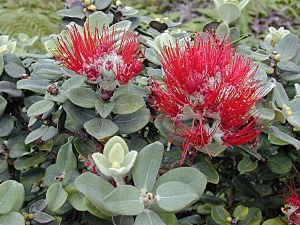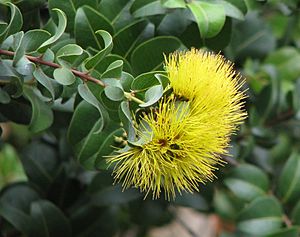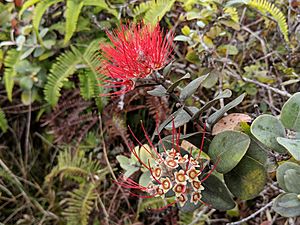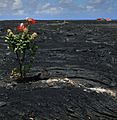Ohia lehua facts for kids
Quick facts for kids ʻŌhiʻa lehua |
|
|---|---|
 |
|
| ʻŌhiʻa lehua flowers | |
| Scientific classification | |
| Genus: |
Metrosideros
|
| Species: |
polymorpha
|
| Varieties | |
|
M. p. var. dieteri |
|
| Synonyms | |
|
List
|
|
The ʻōhiʻa lehua (scientific name: Metrosideros polymorpha) is a beautiful flowering tree. It belongs to the myrtle family. This tree is endemic to the six largest islands of Hawaiʻi. This means it grows naturally only there.
The ʻōhiʻa lehua is a very adaptable tree. It can grow as tall as 20–25 meters (65–82 feet) in good conditions. But it can also be a small, low-growing shrub in boggy areas. It can even grow directly on basalt rock.
Its flowers are very bright and colorful. They are made of many stamens, which are the parts that hold pollen. These flowers can be fiery red or yellow. Many Hawaiian traditions say this tree is special. The forests it forms are sacred to Pele, the volcano goddess. They are also sacred to Laka, the goddess of hula.
ʻŌhiʻa trees can grow easily on lava. They are often the first plants to appear on new lava flows. This helps new land become green again.
Some people think ʻōhiʻa is only for the tree and lehua is only for the flowers. But the word lehua can mean both the flower and the tree itself. So, you can call it a lehua tree, an ʻōhiʻa lehua, or just an ʻōhiʻa.
Contents
Where Does the Ōhiʻa Lehua Grow?
The Metrosideros polymorpha is the most common native tree in the Hawaiian Islands. It can live in many different places. This tree tolerates various soil types, temperatures, and rainfall amounts.
It grows from sea level all the way up to 2,500 meters (8,200 feet) high. You can find it in both wet and dry forests. It also grows in high shrublands. It is a pioneer plant that quickly grows on new lava flows.
This tree grows quite slowly. It is very common in cloud forests above 400 meters (1,300 feet). It also grows in forests that have wet and dry seasons. There, it might grow alone or with the native Acacia koa tree.
What is the Ōhiʻa Lehua Habitat Like?
The Metrosideros polymorpha can be a tall tree or a low-lying shrub. It can also be anything in between. It prefers soil that is acidic to neutral (pH 3.6-7.4). It can grow in many soil types like Histosol, Mollisol, and Oxisol.
It likes rainfall of 1,000–3,000 mm (39–118 inches) per year. But it can also grow in dry forests with only 400 mm (16 inches) of rain. It can even survive in bogs that get over 10,000 mm (390 inches) of rain.
In moist, deep soils, the ʻōhiʻa grows 20–25 meters (65–82 feet) tall. Some trees have even reached 30 meters (98 feet) high. The tree trunk can look different. Some are straight and smooth, while others are twisted.
Trees in forests often have stilt roots. These roots help them grow on fallen logs or tree ferns. The logs decay over time, leaving the tree on its stilt roots. Some trees also have aerial roots to collect moisture from the air. In high, dry, or poor soil areas, the tree usually grows as a shrub.
The flowers are usually bright red. But you can also find orange-red, salmon, pink, yellow, or orange ones. The flowers grow in clusters at the ends of branches. Many stamens stick out from the flower. This gives them their unique pom-pom shape. The leaves have tiny openings called stomata. These can close to protect the plant from harmful gases. This gives the ʻōhiʻa an advantage over many non-native trees.
How Do People Use Ōhiʻa Lehua?
The wood of the ʻōhiʻa lehua is reddish-brown and very hard. It has a fine texture. In ancient Hawaiian society, people used this wood for many things. They built houses and heiau (temples) with it.
They also made papa kuʻi ʻai (boards for making poi). Weapons, tool handles, and hohoa (beaters for making kapa cloth) were also made from ʻōhiʻa wood. They even carved kiʻi (statues and idols) from it.
While the main hull of waʻa (outrigger canoes) was not made from ʻōhiʻa, other parts were. These included seats, gunwales (upper edges), and decking. The curved stilt roots were used for canoe spreaders. Fences were also made from ʻōhiʻa wood because it was easy to find. It was also excellent firewood because it burned hot and clean.
The lehua (flowers) and liko lehua (leaf buds) were used to make beautiful lei. The flowers were also used as medicine. They helped treat pain during childbirth.
The ʻōhiʻa lehua is one of the few native Hawaiian plants that bees use to make honey.
What Other Trees Are Similar to Ōhiʻa Lehua?
There are about 50 species in the Metrosideros group. They are found in Southeast Asia and the Pacific. One species is even found in South Africa.
The Hawaiian Islands have five Metrosideros species that are endemic. This means they grow nowhere else in the world. These are:
- Metrosideros polymorpha (the ʻōhiʻa lehua)
- M. macropus
- M. rugosa
- M. tremuloides
- M. waialealae
You can easily tell these species apart by looking at their leaves.
Metrosideros kermadecensis is a tree from the Kermadec Islands. It has recently started growing in Maui. It might become a problem plant there. Some types of M. excelsa, the pohutukawa tree from New Zealand, are planted in Hawaiʻi as pretty garden trees. But they have not spread into the wild.
The Metrosideros polymorpha was once thought to be a variety of M. collina. That tree is native to other Polynesian islands. But now, scientists agree that Metrosideros polymorpha is its own unique Hawaiian species.
How is Ōhiʻa Lehua Protected?
Metrosideros polymorpha forests in Hawaiʻi face threats from many non-native plants. In wet forests, these include strawberry guava and "purple plague" (Miconia calvescens). In drier areas, problem plants include faya tree and Christmasberry.
Non-native grasses can also grow beneath the trees. This stops new ʻōhiʻa trees from growing naturally. In drier areas, M. polymorpha also has to compete with silk oak and fountain grass.
Rapid ʻŌhiʻa Death
Recently, a serious disease called Rapid 'Ōhi'a Death has attacked ʻōhiʻa forests. This disease is caused by two types of fungus. These fungi were new to science when they were found. They are called C. huliohia and C. lukuohia.
The disease gets its name because healthy trees can die very quickly. They often die within a few days or weeks. While the ʻōhiʻa tree is still very common, some animals that depend on it are in danger. For example, the ʻakekeʻe bird and certain longhorn beetles are affected. This is because the forest areas they live in are shrinking.
In May 2018, infected ʻōhiʻa trees were found on the island of Kauai. People were asked to avoid moving ʻōhiʻa products around the island. This helps prevent the disease from spreading further.
What Does the Name Ōhiʻa Lehua Mean?
The scientific name Metrosideros comes from Greek words. Metra means 'heartwood' and sideron means 'iron'. This refers to the very hard wood of these trees.
The word polymorpha means 'many forms'. This is a good name because this tree can look very different. It grows in many different environments.
The Hawaiian word ʻōhiʻa likely comes from an older word, *kafika. Many similar words are used across Oceania. Most of these words refer to the "mountain apple" tree. In Hawaiʻi, ʻōhiʻa refers to this tree and other similar ones.
The origin of the word lehua is less clear. There are many ideas about where it came from. But no strong evidence has been found yet.
Myths and Legends of the Ōhiʻa Lehua
In Hawaiian mythology, there is a famous story about the ʻōhiʻa tree. It tells of two young lovers named ʻŌhiʻa and Lehua. The volcano goddess Pele fell in love with ʻŌhiʻa. But he did not return her feelings.
Pele became very jealous. In her anger, she turned ʻŌhiʻa into a tree. Lehua was heartbroken by this. The other gods felt sorry for her. So, they turned Lehua into a beautiful flower. They placed her on the ʻōhiʻa tree.
Another version of the story says Pele felt bad about what she did. But she could not change ʻŌhiʻa back. So, she turned Lehua into a flower herself.
It is said that if you pick a lehua flower from an ʻōhiʻa tree, the sky will fill with rain. This rain represents the tears of the separated lovers.
Images for kids
-
A specimen of the species colonizing thirty-year-old pahoehoe flows from Kīlauea at Kalapana, Hawaii.
See also
 In Spanish: Metrosideros polymorpha para niños
In Spanish: Metrosideros polymorpha para niños





